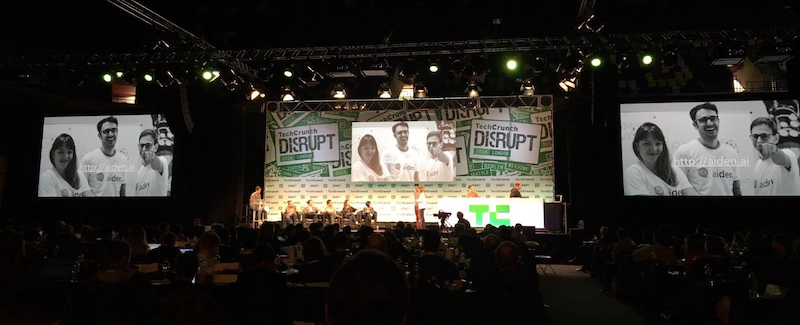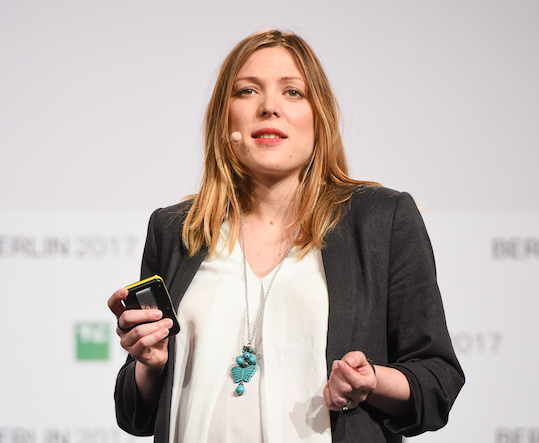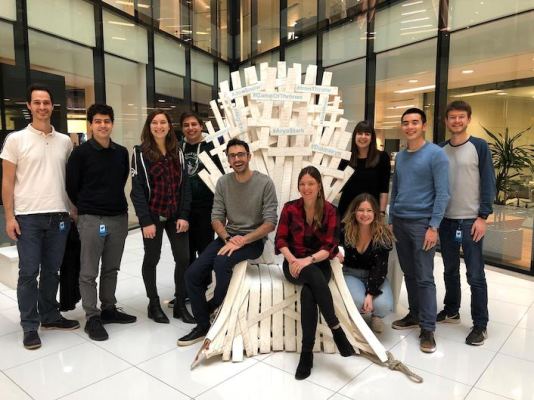By the summer of 2016, Marie Outtier had spent eight years as a consultant advising media agencies and martech companies on marketing growth strategy.
Pierre-Jean “PJ” Camillieri started as a music software engineer before joining one of Apple’s consumer electronics divisions. Inspired by Siri, he left to start Timista, a smart lifestyle assistant.
When the two joined forces to co-found Aiden.ai, the combination was potent — one was a consummate marketer, the other, a specialist in machine learning. Their goal: create an AI-driven marketing analyst that offered actionable advice in real time.
Humans who manage ad campaigns must analyze vast amounts of numbers, but Outtier and Camillieri envisioned a tool that could make optimization recommendations in real time. Analytics are vast and unwieldy, so theirs was a no-brainer proposition with a market crying out for solutions.
The company’s first office was at Bloom Space in Gower Street, London. It was just a handful of hot desks and a nearby sofa shared with four other startups. That summer, they began in earnest to build the company. A few months later, they had a huge opportunity when the still 100% bootstrapped company was selected for Techcrunch Disrupt’s Startup Battlefield competition.
Interviewed by TechCrunch, they explained their proposition: Marketers wanted to know where a digital marketing campaign was getting the most traction: Twitter or Facebook. You might need to check several dashboards across multiple accounts, plus Google analytics to compile the data — and even if you conclude that one platform is outperforming the other, that might change next week as users shift attention to Instagram, potentially wasting 60% of ad spend.
Aiden was intended to feel like just another co-worker, relying on natural language processing to make the exchange feel chatty and comfortable. It queried data from multiple dashboards and quickly compiled it into flash charts, making it easy to find and digest.
Eventually, instead of managing 10 clients, marketing analysts would be able to manage 50 using dynamic predictions as well as visualizations. Aiden incorporated Outtier’s expertise into its algorithms so it could suggest how to tweak a Facebook campaign and anticipate what was going to happen.
Was appearing at Disrupt a significant moment? “It was a big deal for us,” says Outtier. “The exposure gave us ammunition to raise our first round. And being part of the Disrupt Battlefield alumni gave us many meaningful networking and PR opportunities.”
A few weeks later the company had raised a seed round of $750,000. But not without difficulty. By this time Outtier was in the latter stages of pregnancy. Raising money under these circumstances was difficult, but, she says, “it can be done. It’s tougher than ‘normal circumstances.’ It’s a bit like running a marathon, but with a fridge on your back.”
Then there was the usual investor runaround. “Our lead investor pulled out last-minute before Christmas 2017. We had to build back our momentum on the round from scratch, two months before the term of my pregnancy.” She later wrote a Medium post about the experience after appearing on a panel about the subject.
By March 2017 they were on their first investor update. “An exciting first, because it means people are officially backing you and investing in your product vision,” says Outtier. Airbnb, Uber and Wish were their first major clients during the private beta.
Camillieri and Outtier were guided and advised by French VC Jean de La Rochebrochard, who had put together some helpful content to guide new founders. “He doesn’t care about what other VCs think. He has good instincts and a ruthless sense of prioritization,” says Outtier. “He looks out for his portfolio’s ROI, as he should, but with a very special founder-friendly attitude that made him stand out like a sore thumb among traditional investors.”
By December 2017, the company was ready to launch. The team had grown to five, and they launched (again at Techcrunch Disrupt) the product, which now integrated with Twitter, Facebook, Snap and Google.

In June 2018, the group had its first team offsite abroad. “Culture is key at startups, and creating it from scratch is an incredible privilege,” Outter says. “We took the whole gang out to Lisbon to announce that we closed a new round of funding to fuel an ambitious move towards multichannel optimization recommendations.”
Why Lisbon?
“Startups don’t fail because they can’t launch a product early enough. They fail because they underestimate the human component of the adventure. You have to put in work to create a culture that becomes the glue keeping the team together during the hard times. It was the investment we made — I’d do it all over again for my next startup,” says Outtier.
In July 2018, the company moved offices for the second time — into a space that was all theirs. “Of course, it was a baby-friendly office,” Outtier told TechCrunch.
After a year of building the product, the team moved wholesale to San Francisco for three months — a logistical challenge for Camillieri and Outtier who by then both had families with young kids.
“It was like closing your eyes and when you reopen them, instead of being close to London’s Hampstead Heath, making a bottle for your baby and going to a Sunday roast with your family, you live with your colleagues in a flat-share near Pacific Heights in San Francisco for three months,” Outtier tells me.
“And you’re looking at yourself in the mirror thinking, ‘this had better work out!’ Because it is a crazy thing to put your family and yourself through!”
Like many startups, they felt they had to move to the epicenter of the tech world. “We had a feeling that not doing it would come at a much higher cost. The goal was to prepare our international expansion and simulate a sort of ‘DYI acceleration’ program,” says Outtier.
Beyond concerns that an exit would probably not have come if they’d remained in Europe, they believed they needed to rub shoulders with other great SaaS companies to be a great SaaS company.
“We didn’t go there to get acquired, we went there to be with the ‘NBA of SaaS startups,’ learn from the best, implement best practices of product development, product launches, sales and come back to London with an unfair advantage. But by doing this, we started existing in the Silicon Valley startup ecosystem, and it’s a small world,” Outtier says.
As with many things in San Francisco, things happened quickly — four months later, in November 2018, the company announced it had raised $1.6 million in a seed round, led by Partech that included Sophia Bendz of Atomico and Nicolas Pinto, founder of Perceptio (acquired by Apple), to develop its “AI-powered marketing analyst.”
That meant they’d raised a total of $2.3 million; peanuts by Silicon Valley standards, and still only at seed level. But by now battle-hardened, Aiden was launching its full product.
By October 2019, the company had decisions to make.
Outtier blogged:
There is something special about being able to share your team’s vision and product with other founders. When that founder built and now runs two publicly traded companies, it feels really unique. Some meetings make you see the potential of your product differently. PJ and I were fortunate to have one of those with Jack Dorsey— and it changed everything.
The meeting with Dorsey was pivotal. Twitter wanted to bring the Aiden platform in-house to better service its business customers. It was an ideal match.
To announce their decision, Camillieri and Outtier brought the team together. “We all flew to Barcelona for the big reveal. We asked everyone to meet us at the airport with a suitcase on a Monday morning.”
It sounds like a crazy strategy, but it worked. “We turned the announcement into a two-day workshop to discuss how our vision could continue on the other side and how to make the most of what is to come! The look on people’s faces when we asked everyone to sign NDAs in that Airbnb… priceless!” says Outtier.

“There are many ways you can mess up an acquisition. Our team was very excited and passionate about our mission and we were in discussions to raise a Series A. An acquisition is a change of trajectory, and in our case a sudden one, because we did not disclose any parts of our discussions with our employees until we signed a term sheet,” she tells me.
“There was shock, happy shock. It’s a big deal to sell your company, and it came as a surprise as we had other options. We wanted to make sure everyone understood why we were doing this, and why it was a fantastic thing. And whilst it was partly sad because it’s the end of the startup adventure as you know it, it’s a new beginning that deserves to be celebrated,” she adds.
TechCrunch sources say Aiden’s acquisition price was in eight figures, but Outtier declines to comment.
Twitter said it was “deeply impressed by the forward-looking nature of the team” and the technology they’d built. In an effort to “unlock Twitter ads” for small businesses even further, Twitter wanted Aiden’s team and technology for its unified, cross-platform command center for paid acquisition campaigns and AI-powered recommendations.
“The Aiden team has a great, great product and obviously we’re excited to have them here at Twitter,” a company spokesperson told TechCrunch. “Every team we onboard is a little bit different in how we onboard them, whether it’s an acquisition or aqua-hire.”
The spokesperson confirmed this a full acquisition and added that Twitter was still “figuring out” how to implement Aiden’s different technologies.
Next, Twitter is “figuring out exactly what sort of projects” the Aiden team will work on. “Learning the ins and outs of just being at Twitter is a whole new experience, especially for really impressive people like Marie who are great entrepreneurs, who are used to running the show,” they said.
Newly acquired startups at Twitter go through new hire orientation called “Flight School.” Beyond that, it depends on the team, whether it’s about technology or revenue or engineering. But one thing is confirmed by Twitter. Aiden did indeed meet Jack Dorsey: “He was excited to meet them and our Corp dev team… facilitated that meeting.”
It would be fair to speculate then that Twitter went out of its way to woo the Aiden team over. But perhaps more importantly, is Twitter baby-friendly?
“Hugely so,” says Outtier. “Twitter is incredibly baby-friendly and has dedicated Slack channels with parents as well as impressive resources to support dads (five months paid paternity leave!) and mums along the journey (breastfeeding rooms, etc.).”
She said she believes being family-friendly will become hugely important in the future: “Most startups consider this a ‘nice-to-have,’ i.e. optional. Those startups will lose out in the long term: inclusive and diverse companies generate more profit on average. Plus, the best talent doesn’t go to old school, gendered startups: one of the first reasons they leave the traditional corporate world is to experience something new, not the same thing but with bean bags and a foosball table.”
Lastly, how long does Outtier think she will stay at Twitter?
“Like with any company you work for, it’s key to keep things interesting, and whereas I can’t predict the future, I can say that I am very grateful that we have been given such an exciting role and an ambitious mission. I’m convinced about the company’s vision and execution, and if you reach a point where your startup is getting acquired, what more can you wish for? It’s a founder’s dream.”
